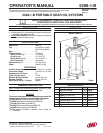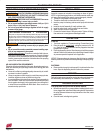
5298Ć1ĆB
Page 2 of 2
PLACING INTO SERVICE
OPERATING AND SAFETY PRECAUTIONS
WARNING
READ THE GENERAL INFORMATION MANUAL
INCLUDED FOR OPERATING AND SAFETY PRECAUTIONS
AND OTHER IMPORTANT INFORMATION.
WARNING
EXCESSIVE INLET AIR PRESSURE. Can cause
explosion resulting in severe injury or death.
• Do not exceed maximum operating pressure of 450 p.s.i. (31.0
bar) at 150 p.s.i. (10.3 bar) inlet air pressure.
• Do not run pump without using a regulator to limit air supply
pressure to the pump.
PUMP RATIO X
INLET PRESSURE TO PUMP MOTOR
=
MAXIMUM PUMP
FLUID PRESSURE
Pump ratio is an expression of the relationship between the pump motor area and
the lower pump end area. EXAMPLE: When 150 p.s.i. (10.3 bar) inlet pressure is
supplied to the motor of a 3:1 ratio pump it will develop a maximum of 450 p.s.i.
(31.0 bar) fluid pressure (at no flow) Ć as the fluid control is opened, the flow rate will
increase as the motor cycle rate increases to keep up with the demand.
WARNING
EXCESSIVE MATERIAL PRESSURE. Can cause
equipment failure resulting in severe injury or property damĆ
age.
• Do not exceed the maximum material pressure handling capaĆ
bility of any component in the system.
Thermal expansion hazard. This can occur when the fluid in the maĆ
terial line is exposed to elevated temperatures. Example: Material
line located in a nonĆinsulated roof area can warm due to sunlight.
Install a pressure relief valve in the fluid outlet side of the pumping
system if this condition could exist.
AIR AND LUBRICATION REQUIREMENTS
Filtered air will help extend the life of the pump, allowing the pump to opĆ
erate more efficiently and yield longer service life to moving parts and
mechanisms.
• Use an air line filter to provide good quality clean and dry air, install it
up stream from the air regulator.
• Use an air regulator on the air supply to control the pump cycle rate,
install the regulator as close as possible to the pump.
• In most installations lubrication is not required. If the pump needs to
have lubrication, install an air line lubricator between the pump and
the air regulator and supply it with a good grade of nonĆdetergent oil
or other lubricant compatible with Nitrile seals. Set at a rate not to
exceed one drop per minute.
INSTALLATION
Assemble components included in the package as shown in figure 1.
NOTE: In rigid plumbing applications, use flexible material and air supĆ
ply hoses when attaching the pump to prevent damage by vibration.
1. Thread the bung adapter into the pump cover.
2. Thread the down tube into the bottom of the pump.
3. Insert the pump into the bung and secure the pump with the thumb
screws.
4. Install the shutĆoff assembly (if used) and drum dolly.
5. Install the outlet nipple, meter, material hose and nozzle.
6. Attach a coupler to the air supply hose.
7. Connect the material hose to the pump outlet. Tighten all fittings.
Use caution not to overtighten and damage threads.
OPERATION
STARTĆUP
1. Turn the air regulator to 0" pressure setting. Connect the air hose.
2. Prime the pump by cycling slowly, raising the pressure to 20 Ć 30
p.s.i. Cycle the pump until the test oil and any trapped air has been
purged from the system.
3. Close the dispensing device. Allow the pump to build line pressure
and stall. Check for any leaks and reĆtorque fittings if needed. Adjust
air pressure upward as required for the application.
NOTICE: If the pump does not prime soon after initial startĆup, establish
what the problem is to prevent unnecessary damage to the pump plungĆ
er.
SHUTDOWN
• Disconnect the air supply from the pump if it is to be inactive for a few
hours. Open the dispensing device to relieve line pressure.
SERVICE
Refer to the basic pump manual for service instructions which also covĆ
ers disassembly and reassembly for installation of the rebuild kit.
TROUBLE SHOOTING
If the pump does not cycle or will not deliver material.
• Be certain to check for nonĆpump problems including kinked, restricĆ
tive or plugged inlet / outlet hose or dispensing device. Depressurize
the pump system and clean out any obstructions in the inlet / outlet
material lines.
• Check all seals, including track gaskets.
PN 97999Ć1145




